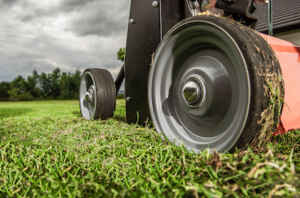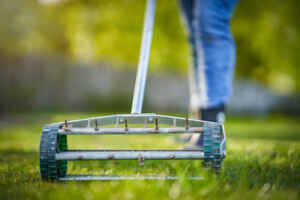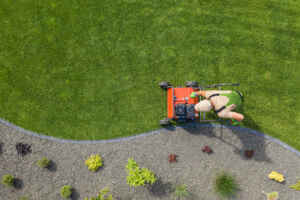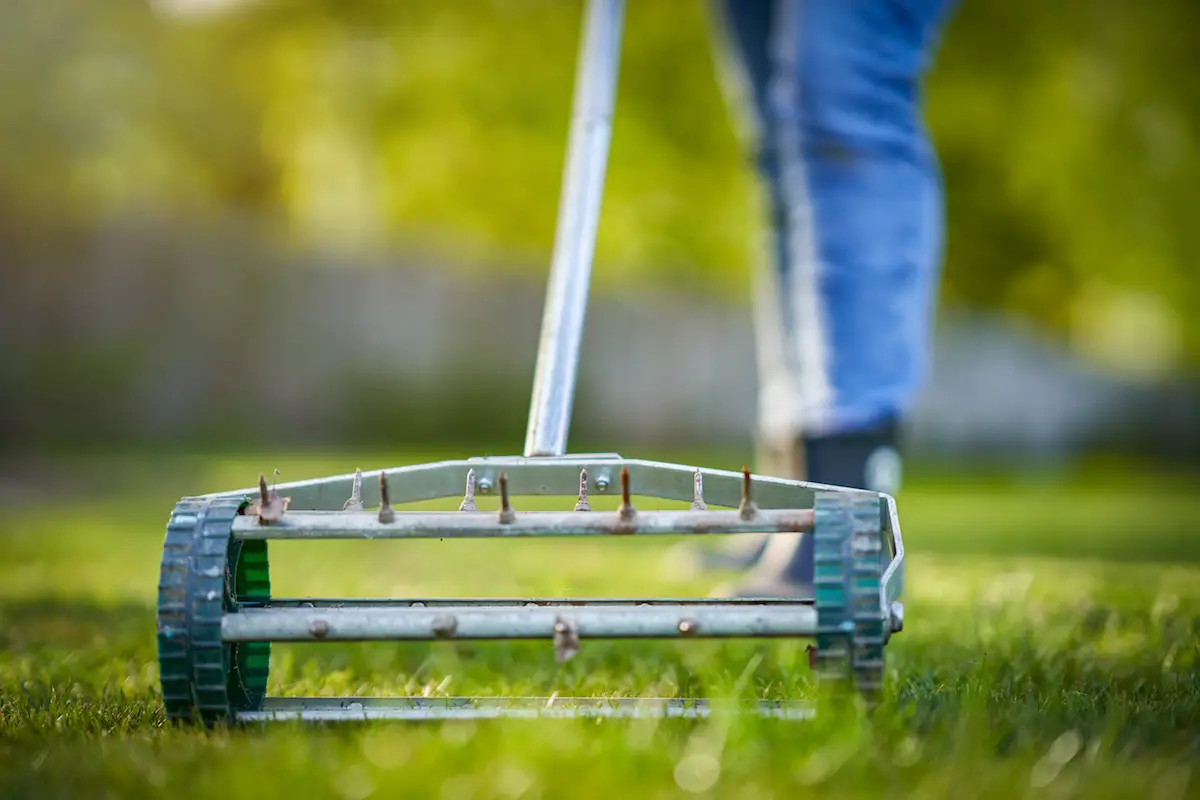Should I Aerate My Lawn In Spring or Fall?
Aeration can help keep your lawn beautiful and healthy. It will allow the needed nutrients, water, air, and other essential items to penetrate your soil. Sometimes we do not even realize our lawns need aerating. If the soil in your lawn gets compacted, aerating it is necessary. However, many of us do not know when it is the best time to aerate our lawns. Some will say you should aerate your lawn in the spring or the fall.
So is it better to aerate your lawn in the spring or the fall? The answer to this question depends on your particular type of grass. You should aerate your grass during its peak time for natural growth (during its growing season). For cool-season grasses, you should aerate in the fall and early spring. Warm-season grasses should be aerated in the late spring or early summer.
In my quest for a better lawn, I spent some time researching the technique of aeration and when it is needed. So, in this post, I will discuss aerating your lawn further, how to do it, and what to do after you aerate. Lawn aeration is a needed tool for successful lawn maintenance. Recognizing the state of your lawn and understanding aeration could mean the difference between having the lawn of your dreams or not. I will give you helpful strategies and knowledge to help you reach your lawn goals!
The Best Time to Aerate Your Lawn
Knowing the best time to aerate your lawn is based on a few factors. You need to know the type of grass you have in your lawn, examine the climate that your grass is growing, and the amount of moisture your lawn has already received.
The best time to aerate your lawn will be when there is the most root growth (growing season). Early fall or spring is the best time to aerate your grass for cool-season grasses such as bluegrass, ryegrass, and fescues. If you have warm-season grass such as St. Augustine, Centipede, or Zoysia, the best time to aerate is late spring or very early summer.
If you aerate your grass at the wrong time, you can risk stressing your grass. However, one of the most important things to remember when aerating your grass is the amount of moisture already in the soil. You will get your best aeration results when the ground is moist from irrigation or rainfall prior to treating the soil. Soil that is overly dry makes aeration challenging to accomplish.

How Do I Know If My Lawn Is Compacted?
Compacting can arise from heavy pressure on your soil. Large machines can compact soil during home construction, excessive foot traffic, and even heavy rain. Compacted soil causes your soil to be unable to retain moisture, nutrients, and the oxygen it needs for healthy growth. This can cause your grass to become visibly weak, discolored, and unhealthy.
Signs that your soil may be compacted include grass not growing in the summer, water puddles forming in low areas of your lawn, water running away from high areas of lawn, thin and patchy areas of grass, heavy clay soil, and bare dirt areas where weeds will not even grow. Lastly, compacted soil can be so hard a shovel cannot even pierce it.
The only solution is lawn aeration when you have any or an assortment of these issues. Aeration treatment involves placing small holes in your soil. This is to allow air, water, and nutrients to break through your compacted soil and reach your grass’s root system. Aeration will cause your grass to be healthier and enable your soil to hold more water. Aeration also allows air to be available for root respiration. Nutrients will now be maintained in the soil for your grass roots to absorb. Aeration is a needed lawn treatment to help maintain the life of your lawn. Without aeration, you will be fighting a battle with your lawn without the proper treatment to cause your lawn to flourish.
How Do I Aerate My Lawn?
Now that you know when to aerate your lawn for the best results, you might be wondering about the best methods to get aeration done. There are many things that can cause your grass to get compacted and need aeration. Heavy recreation use, lawnmowers, pets, and even excessive foot traffic can cause the grass to get compacted. To properly aerate your lawn, tools that you can purchase are lawn aerators and power rakes.
Aerator equipment can be small and used manually or large and tractor-like. Spike aerators poke a hole into the soil with a spike-like tine. Slicing aerators have rotating blades. These blades slice through the grass and thatch to reach the soil. This leaves a way for air, water, and nutrients to reach the soil. Professionals generally use core/plug aerators. They use rows of tine to remove plugs of soil and place them on top of the soil. This enables the plugs to break down. You can purchase or rent this equipment.

What Happens After I Aerate My Lawn?
There are many things you can do after you aerate your lawn. After you complete the aeration, you should let the plugs of soil dry wherever they are on your lawn. They will add nutrient-rich soil and organic matter to your lawn when they break down. Also, it is recommended that the following aeration is one of the best times to over-seed and fertilize your lawn. The aerator-created openings will allow lawn treatment to penetrate through the openings and have greater contact with your grasses root system. You should also water your grass heavily. This will encourage your grass to grow deeper roots. Once you have aerated, overseeded, fertilized, and watered, you should leave the grass alone to let it properly germinate. After this process has been completed, you will need to check your lawn to ensure your soil’s core is dry before mowing.
Do I Need to Dethatch or Aerate My Lawn?
Lawn dethatching removes debris and organic matter on your soil’s surface. This excessive debris can hinder sunlight, water, oxygen, and nutrients from reaching your grasses roots. Thatch is the layer of dead grass, leaves, and other organic matter under the grass blades on the surface of your soil. Aeration is used to give your grass’s roots space to grow. Aeration removes plugs from your soil, and dethatching eliminates the layer of thatch on your soil’s surface. If you properly aerate your lawn, you will not have the need to dethatch. Aeration causes you to have looser, less compacted soil which helps stimulate the soil and microbes, which can assist with decomposing the thatch layer. Unfortunately, your lawn can still need dethatching and aerating. If this is the case, it is better to dethatch before aerating. This will make the aerating process much more manageable.

Related Questions
What Are Some Signs My Lawn Needs Aeration? Dethatching?
There are clear signs that your lawn needs aeration or dethatching. Your lawn may need aeration if the soil is hard to the touch, you are seeing exploding weed growth, or your grass is yellowing. Other signs include slow-growing grass, or your trees and shrubs are wilting, their leaves are scorched, are the wrong color, or experiencing dieback. These are all indicators that your lawn needs aeration. Your lawn might need dethatching if the ground feels spongy or springy. If the grass blades are thinning and weak (seeing dry spots) are indicators of thatch in your lawn. Another indicator is more weeds, loss of grass color, and insect issues. Lastly, if you find your lawn sensitive to temperature extremes or you notice fungal diseases in your lawn.
What Is the Cost of Professional Aeration?
You can do it yourself or pay a professional to aerate your lawn. If you decide to do it yourself, prices can range from $25 to $200. You will incur manual aerator cost, mower attachment, rental, seed, and fertilizer. Professional costs you can incur can range. Generally, you will have to pay the professional per hour up to $35. Professional service can range up to $20 per square foot. You also should add the costs of overseeding and fertilization. Most healthy lawns should be aerated every two to three years.
When Should I Fertilize My Lawn If I Aerate?
A few factors will help you determine the best time to fertilize your lawn. One of the essential items that will help you know when to fertilize your lawn is where you live. Where you live will determine when the ground temperature is best for fertilizer. In general, grass should be fertilized at a minimum twice per year. However, your frequency is based on your climate and the type of grass you have. It is best to fertilize your lawn when the ground is 55 degrees Fahrenheit. You also need to be aware of the kind of grass your lawn has. This will impact the time you fertilize your lawn as well.
In Closing
In conclusion, remember there is no one answer to when is the best time to aerate your lawn. As it depends on a number of factors, including the type of grass you have, the climate you live in, and the amount of traffic your lawn gets. Also, remember that aerating your lawn is very important. As it will improve its overall health, so it’s worth taking the time to do it right. Hopefully, this article about aeration and when to aerate your lawn answered your questions and was helpful in improving your lawn. Thank you for reading!

